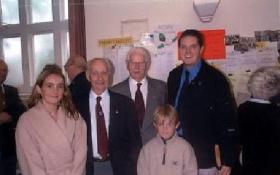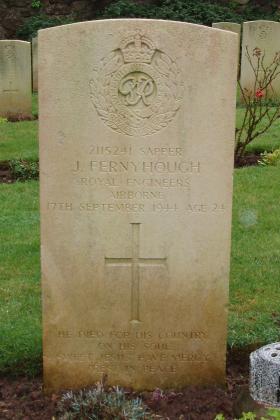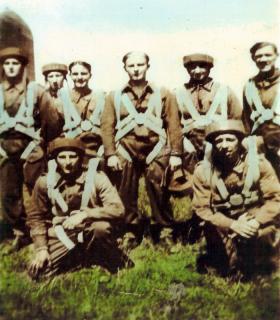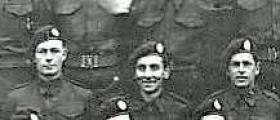John Fernyhough was born on 7 December 1919, at 57 Victoria Street, Silverdale (a Staffordshire coal-mining village), the son of Clement Thomas Fernyhough (a miner) and Mary Fernyhough (nee Scally). John attended St. Patrick’s RC School in Newcastle-under-Lyme, leaving at the age of 14 to become a carpenter. He was a keen cyclist and powerful swimmer who competed in water polo and other swimming events. He volunteered in 1939 enlisting in the Royal Engineers.
On 16 December 1941, John married Ethel (known as Dinah) Beardmore, of Shelton, Stoke-on-Trent. Later, in 1943, they had a daughter Valerie.
Conversion to Airborne
Early in 1942 the Company was selected to train as an airborne unit and during the period of transition was stationed at Bulford. By May 1942 they were re-designated as the 9th Field Company R.E. (Airborne) and, on 19 June 1942, became part of the 1st Airlanding Brigade, 1st Airborne Division. All personnel in the Company were trained as glider-borne troops. Some of the Company’s strength also trained as parachutists at Ringway, Manchester; their drop zone being at Tatton Park, near Knutsford.
Course 14, which ran from 25 May 1942 to 4 June 1942, contained a total intake of 200 men comprising men from both the Parachute and Airlanding Brigades. Forty men from 9 Field Coy attended, 38 qualified as parachutists including Sappers Fernyhough and Watt who both completed 2 balloon jumps and 5 aircraft descents. Watt was later to travel in the same glider as John Fernyhough to Arnhem. Weather conditions on the course were very variable leading to a lot of waiting about for suitable jump conditions; there were numerous injuries and also a fatality on the course.
Twenty volunteers from the Company were amongst the forty-one who died during the ill-fated, glider-borne Operation Freshman on 19 November 1942 to destroy a heavy water plant in Norway. (See separate account on ParaData).
Sicily and Italy
On 16 April 1943 the Company sailed from Gourock, on the River Clyde, in the liner Boissevain bound for North Africa. On 9/10 July 1943, the Company, as part of the 1st Airlanding Brigade, was engaged in Operation Ladbroke, the first of two hazardous glider landings in Sicily. Some men from the 9th assisted in the capture of the Ponte Grande bridge near Syracuse and others in the Company dealt with coastal defences which could be an impediment to the main invasion force. After being relieved by the advance spearhead of the invasion force, on 16 July, they were taken back to Tunisia in Infantry Landing Craft.
On 8 September 1943, the whole Company sailed from Bizerta in the American cruiser U.S.S. Boise for Operation Slapstick, as part of the invasion of mainland Italy, and during the voyage they learned that the Italian forces had capitulated. They landed at the port of Taranto and for the next month they carried out various tasks including repairs to the dock and mine clearance. The 9th later moved forward with the advancing forces and on occasions small parties operated behind enemy lines cutting railway lines thereby denying the Germans reinforcements and supplies. A detachment of eight Sappers under Corporal Roy Allen sailed in an Infantry Landing Craft to Salerno where they cleared about 700 mines from the beaches.
Operation Market Garden
The 9th returned to the UK in SS Duchess of Bedford, landing at Liverpool on 12 December 1943 and moved to Lincolnshire. Company H.Q. was in the village of Tattershall and their billets were in the nearby village of Coningsby. The 9th soon became involved in a series of exercises in preparation for the invasion of Western Europe. In May 1944 the Company moved south to Hurn in Hampshire to prepare the airfield for Operation Overlord (D Day). They extended the runway and carried out other construction work before moving back to Lincolnshire in early June. A number of planned airborne operations were abandoned before the Company was finally redeployed in Operation Market (the Airborne element of Operation Market Garden).
Just after 10.00 hours on Sunday 17 September 1944 sixteen glider and tug combinations took off from RAF Keevil for Arnhem as part of Operation Market Garden. Horsa Glider RJ113 (Chalk 389) was in this group of aircraft and contained 21 men, including John Fernyhough, from No 1 Platoon 9th (Airborne) Field Company Royal Engineers. The glider was flown by S/Sgt L J Gardner and co-pilot Sgt R A Fraser from D Squadron, The Glider Pilot Regiment. It was towed by a Short Stirling, No. LK 148 of 299 Squadron, 38 Group.
The tugs and gliders took a course north-west towards Gloucester to pick up Squadrons from Fairford and then headed out over the Severn and Bristol Channels to form up. Here Stirling LK 148 with Horsa Glider R113 took a turn south-west down the Bristol Channel with other aircraft and gliders, and made a turn east over Weston-Super-Mare and headed for Arnhem.
While over the village of Farrington Gurney an explosion occurred in RJ113 splitting the glider in two. With no tail section the glider lost lift, broke its tow line and crashed into the Double Hills meadow near Paulton killing all occupants. The event was witnessed by the Stirling’s rear gunner who recalls watching the glider falling like a rock to earth after the explosion had occurred.
One villager was in the field picking blackberries at the time of the crash and was injured by flying metal fragments. The Stirling marked the spot by circling until they could see locals running to the crash site. This included Farmer Teak: “When I arrived at the place of the crash I could see that there was nothing I could do. The soldiers had all been killed. It was gruesome.”
As a result of the explosion on board John and his comrades became the first casualties of Operation Market Garden. He is commemorated on the Double Hills memorial at the site of the crash along with the other 22 occupants of the glider.
Sapper Fernyhough died on 17 September 1944, aged 24 years old. He is now buried in plot Y.300 at the Milton Road Cemetery, Weston Super Mare along with other soldiers killed by the crash.
Further Reading:
Pronk, P, Airborne Engineers: The Shiny 9th (2001), R.N. Sigmond Publishing.
Profile compiled for ParaData by Harvey Grenville based on the work of Peter Yeates, Bob Williams and the Double Hills Memorial Group.
Read More





Latest Comments
There are currently no comments for this content.
Add Comment
In order to add comments you must be registered with ParaData.
If you are currently a ParaData member please login.
If you are not currently a ParaData member but wish to get involved please register.